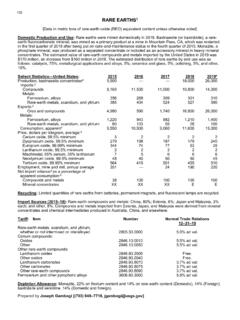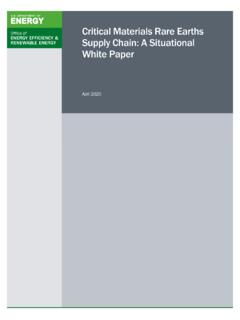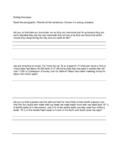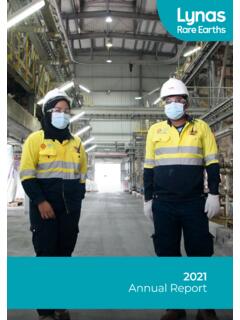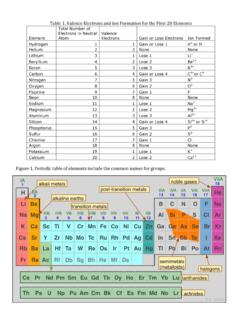Transcription of Earth's Orbit & Rotation | 5E Lesson Plan | Grades 3-5
1 SUMMARYS tudents will learn about the apparent motion of the earth , sun, stars, and planets by studying observable patterns. CORRELATION5-ESS1-2 Represent data in graphical displays to reveal patterns of daily changes in length and direction of shadows, day and night, and the seasonal appearance of some stars in the night sky. 2018 1 Lesson PLANEARTH S Orbit AND ROTATIONGRADES 3-5 Science & Engineering PracticesAnalyzing and Interpreting DataAdditional SEP addressed by this Lesson :Developing and Using Models Students create a pictograph or chart revealing patterns in the relationship between the stars visible in the night sky and the time of year indicative of a relationship between the motion of the earth and the Sun (extension).
2 Students observe and develop models to help visualize the motion of the earth in relation to the sun and other to Classroom ActivityDisciplinary Core IdeasConnections to Classroom : earth and the Solar System The orbits of earth around the sun and of the moon around earth , together with the Rotation of earth about an axis between its North and South poles, cause observable patterns. These include day and night; Students observe patterns related to the Rotation of the earth (day and night, length of shadows, apparent motion of the Sun) and Orbit of the earth around the Sun (changes in stars visible at certain times of year).Link to Video Chalk Access to parking lot or playground Watch Toothpicks (at least one per group of 4 students) Clay Ball or globe Flashlights (at least one per group of 4 students) Science notebooks & pencils (1 per student)DIY Activity Materials Paper plate Glue stick A bendable straw Tape A compass Sundial face printout (located under video) Sharpened pencil Watch MATERIALSDURATION 3 x 10 min outside for shadow observation (different times of day), then one 45-minute classroom period, then 3 x 10 min outside for sundial observation (different times of day).
3 PRE-ASSESSMENT QUESTIONSP lease see Discussion Questions located under the video. These can be discussed as a group or answered individually in student science notebooks. ENGAGEOn a sunny day during the morning, take students outside to a parking lot or other surface you can draw on with chalk. Give each student a piece of chalk. Instruct them to draw an x in a location of their choosing. Then ask them to write their initials near the x. Working with a partner, have one student stand on the x with their initials, while their partner loosely traces their shadow on the ground. Then the partners should trade places. The time of day should be written inside this shadow. This process should be repeated around noon, and again later in the 2018 ConceptsConnections to Classroom ActivityPatterns (3-ESS2-1, 3-ESS2-2)Similarities and differences in patterns can be used to sort, classify, communicate and analyze simple rates of change for natural phenomena.
4 Students explore patterns related to night and day, apparent motion of the sun, shadow lengths, changing visible stars and constellations, Foucault s pendulum, calendars and time changes in the length and direction of shadows; and different positions of the sun, moon, and stars at different times of the day, month, and DCI addressed by this Lesson : Some objects in the solar system can be seen with the naked eye. Planets in the night sky change positions and are not always visible from earth as they Orbit the sun. Stars appear in patterns called constellations, which can be used for navigation and appear to move together across the sky because of earth s Rotation . Students observe and discuss evidence that earth is rotating on its axis and evidence that earth is orbiting the Sun (vs.)
5 The Sun orbiting the earth ). Students observe and discuss objects seen through a telescope vs. the naked eye. Students observe and determine why planets are not always visible from earth as they also Orbit the Sun. EXPLOREA fter the entire Engage exercise has been completed, ask students to discuss the phenomena they observed using sunlight, shadows, and chalk. What do they think happened? Students may know, or think they know (but they may think the sun moved across the sky). Break students into small groups and give each group a flashlight, toothpick, and small piece of clay. Let them explore using these tools to model what they observed outside and attempt to construct an explanation.
6 A sketch of their model explaining what each piece represents (flashlight represents sun, toothpick represents person, etc.), along with a written explanation of what they think is happening, should be written into their science notebooks. EXPLAINF acilitate a group discussion about how and why shadows change length and direction. Some students will have will have correctly modeled this phenomena by moving the flashlight. Show students an alternative model with a toothpick stuck to a ball using clay. Have a volunteer hold the flashlight in one place and rotate the ball. Does this produce the same effect? Is the sun moving across the sky or is the earth moving? How can we be sure?
7 WATCH THE GENERATION GENIUS earth S Orbit AND Rotation VIDEO AS A GROUPThen facilitate a conversation using the Discussion Questions. ELABORATEUse the DIY Activity to build your own sundials just like Zo s from the video. More advanced concepts related to the motion of the earth can be explored using the sundial as a starting point. EVALUATEIn their science notebooks, each student should use words and/or labeled drawings to explain the motion ( Rotation and Orbit ) of the earth in relation to the sun, and list some of the patterns that motion causes (apparent motion of sun, shadows, day and night, visibility of certain stars throughout the year). EXTENSIONSR esearch or observe which stars/constellations are visible where you live over time to create a chart showing when different constellations are visible throughout the year.
8 Explain why we can see these different constellations in a repeating pattern (because the earth orbits the sun once a year and the pattern repeats each year). Next Generation Science Standards is a registered trademark of Achieve, Inc. A non-profit dedicated to raising academic standards and graduation plan written by Mountain Goat Instructional Design. 2018 3

![What is Science? | 5E Lesson Plan for Grades K-2 [PDF]](/cache/preview/7/4/e/4/1/3/6/3/thumb-74e41363994c2eb466bf861bbe860774.jpg)
![Natural Disasters | 5E Lesson Plan for Grades 3-5 [PDF]](/cache/preview/8/0/9/c/e/7/2/f/thumb-809ce72f931e610fe94c698182f94da5.jpg)
![Weathering & Erosion | 5E Lesson Plan for Grades 3-5 [PDF]](/cache/preview/f/0/5/2/c/e/5/b/thumb-f052ce5b2e69fc2ea580a59cb704d9d6.jpg)
![Living vs. Non-Living | 5E Lesson Plan for Grades K-2 [PDF]](/cache/preview/1/5/0/5/c/1/5/2/thumb-1505c15273daf157385e9717a453fa28.jpg)
![Ecosystems | 5E Lesson Plan for Grades 3-5 [PDF]](/cache/preview/3/7/3/5/6/2/e/1/thumb-373562e11bfd5c636d56d01f227d09a5.jpg)

![Sun & Stars | 5E Lesson Plan for Grades 3-5 [PDF]](/cache/preview/3/8/9/6/7/a/2/9/thumb-38967a29ac1fe92fba7fa7d775945b90.jpg)
![Human Body Systems | 5E Lesson Plan for Grades 3-5 [PDF]](/cache/preview/5/3/7/d/5/f/0/a/thumb-537d5f0a980c7ec9133056914a11eb75.jpg)
![Weather vs. Climate | 5E Lesson Plan for Grades 3-5 [PDF]](/cache/preview/d/7/c/0/6/c/d/6/thumb-d7c06cd6fdf48a1bc04b4f1b0e7e23b6.jpg)
